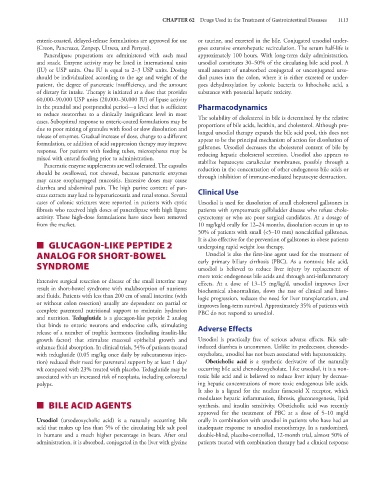Page 1127 - Basic _ Clinical Pharmacology ( PDFDrive )
P. 1127
CHAPTER 62 Drugs Used in the Treatment of Gastrointestinal Diseases 1113
enteric-coasted, delayed-release formulations are approved for use or taurine, and excreted in the bile. Conjugated ursodiol under-
(Creon, Pancreaze, Zenpep, Ultresa, and Pertyze). goes extensive enterohepatic recirculation. The serum half-life is
Pancrelipase preparations are administered with each meal approximately 100 hours. With long-term daily administration,
and snack. Enzyme activity may be listed in international units ursodiol constitutes 30–50% of the circulating bile acid pool. A
(IU) or USP units. One IU is equal to 2–3 USP units. Dosing small amount of unabsorbed conjugated or unconjugated urso-
should be individualized according to the age and weight of the diol passes into the colon, where it is either excreted or under-
patient, the degree of pancreatic insufficiency, and the amount goes dehydroxylation by colonic bacteria to lithocholic acid, a
of dietary fat intake. Therapy is initiated at a dose that provides substance with potential hepatic toxicity.
60,000–90,000 USP units (20,000–30,000 IU) of lipase activity
in the prandial and postprandial period—a level that is sufficient Pharmacodynamics
to reduce steatorrhea to a clinically insignificant level in most The solubility of cholesterol in bile is determined by the relative
cases. Suboptimal response to enteric-coated formulations may be proportions of bile acids, lecithin, and cholesterol. Although pro-
due to poor mixing of granules with food or slow dissolution and longed ursodiol therapy expands the bile acid pool, this does not
release of enzymes. Gradual increase of dose, change to a different appear to be the principal mechanism of action for dissolution of
formulation, or addition of acid suppression therapy may improve gallstones. Ursodiol decreases the cholesterol content of bile by
response. For patients with feeding tubes, microspheres may be reducing hepatic cholesterol secretion. Ursodiol also appears to
mixed with enteral feeding prior to administration. stabilize hepatocyte canalicular membranes, possibly through a
Pancreatic enzyme supplements are well tolerated. The capsules
should be swallowed, not chewed, because pancreatic enzymes reduction in the concentration of other endogenous bile acids or
through inhibition of immune-mediated hepatocyte destruction.
may cause oropharyngeal mucositis. Excessive doses may cause
diarrhea and abdominal pain. The high purine content of pan-
creas extracts may lead to hyperuricosuria and renal stones. Several Clinical Use
cases of colonic strictures were reported in patients with cystic Ursodiol is used for dissolution of small cholesterol gallstones in
fibrosis who received high doses of pancrelipase with high lipase patients with symptomatic gallbladder disease who refuse chole-
activity. These high-dose formulations have since been removed cystectomy or who are poor surgical candidates. At a dosage of
from the market. 10 mg/kg/d orally for 12–24 months, dissolution occurs in up to
50% of patients with small (<5–10 mm) noncalcified gallstones.
It is also effective for the prevention of gallstones in obese patients
■ GLUCAGON-LIKE PEPTIDE 2 undergoing rapid weight loss therapy.
ANALOG FOR SHORT-BOWEL Ursodiol is also the first-line agent used for the treatment of
SYNDROME early primary biliary cirrhosis (PBC). As a nontoxic bile acid,
ursodiol is believed to reduce liver injury by replacement of
more toxic endogenous bile acids and through anti-inflammatory
Extensive surgical resection or disease of the small intestine may effects. At a dose of 13–15 mg/kg/d, ursodiol improves liver
result in short-bowel syndrome with malabsorption of nutrients biochemical abnormalities, slows the rate of clinical and histo-
and fluids. Patients with less than 200 cm of small intestine (with logic progression, reduces the need for liver transplantation, and
or without colon resection) usually are dependent on partial or improves long-term survival. Approximately 35% of patients with
complete parenteral nutritional support to maintain hydration PBC do not respond to ursodiol.
and nutrition. Teduglutide is a glucagon-like peptide 2 analog
that binds to enteric neurons and endocrine cells, stimulating Adverse Effects
release of a number of trophic hormones (including insulin-like
growth factor) that stimulate mucosal epithelial growth and Ursodiol is practically free of serious adverse effects. Bile salt-
enhance fluid absorption. In clinical trials, 54% of patients treated induced diarrhea is uncommon. Unlike its predecessor, chenode-
with teduglutide (0.05 mg/kg once daily by subcutaneous injec- oxycholate, ursodiol has not been associated with hepatotoxicity.
tion) reduced their need for parenteral support by at least 1 day/ Obeticholic acid is a synthetic derivative of the naturally
wk compared with 23% treated with placebo. Teduglutide may be occurring bile acid chenodeoxycholate. Like ursodiol, it is a non-
associated with an increased risk of neoplasia, including colorectal toxic bile acid and is believed to reduce liver injury by decreas-
polyps. ing hepatic concentrations of more toxic endogenous bile acids.
It also is a ligand for the nuclear farnesoid X receptor, which
modulates hepatic inflammation, fibrosis, gluconeogenesis, lipid
■ BILE ACID AGENTS synthesis, and insulin sensitivity. Obeticholic acid was recently
approved for the treatment of PBC at a dose of 5–10 mg/d
Ursodiol (ursodeoxycholic acid) is a naturally occurring bile orally in combination with ursodiol in patients who have had an
acid that makes up less than 5% of the circulating bile salt pool inadequate response to ursodiol monotherapy. In a randomized,
in humans and a much higher percentage in bears. After oral double-blind, placebo-controlled, 12-month trial, almost 50% of
administration, it is absorbed, conjugated in the liver with glycine patients treated with combination therapy had a clinical response

